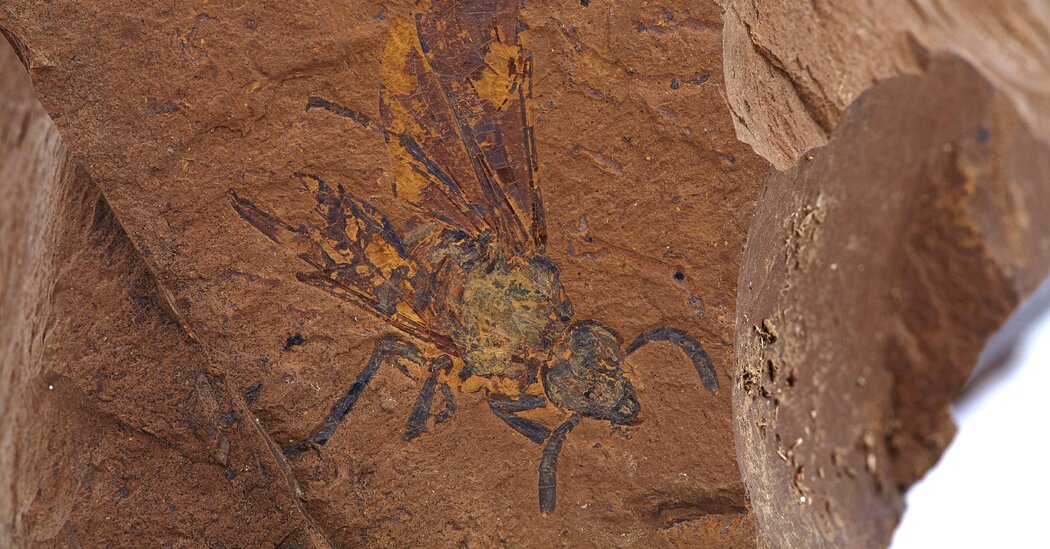Australia’s Central Tablelands, hundreds of miles northwest of Sydney, are dominated today by grasses and spindly trees. But scientists recently discovered that some of the area’s rusted rocks conceal traces of the lush rainforests that covered the area 15 million years ago during the Miocene Epoch.
The area, McGraths Flat, is not Australia’s only Miocene deposit, but these new fossils are a paleontological boon because of their exquisite preservation. Over the past three years paleontologists have excavated flowers, insects and even a bird’s wispy feather.
The scientists’ discoveries, published Friday in the journal Science Advances, help reconstruct Australia’s Miocene rainforest in extensive detail, and the site “opens a whole new area of exploration for Australian paleontology,” said Scott Hocknull, a paleontologist at Queensland Museum who was not involved in the research.
Fifteen million years ago, a river carved through the jungle, leaving an oxbow lake (known as a billabong in Australia) in its wake at McGraths Flat. Nearly devoid of oxygen, this stagnant pool kept scavengers at bay, allowing plant material and animal carcasses to accumulate. As iron-rich runoff from nearby basalt mountains seeped into the billabong, the pool’s low pH caused the iron to precipitate and encase the organic material. As a result, the fossils at McGraths Flat are preserved in a dense, iron-rich rock known as goethite.
This method of fossilization is uncommon, Dr. Hocknull said. Because quality fossils are rarely found in igneous rocks, paleontologists often overlook them. However, the fossils from McGraths Flat illustrate that goethite, which is common in Australia, can yield remarkable fossils.
“There’s no shortage of goethite,” Dr. Hocknull said. “We’re essentially a rusting country.”
Because of their iron-tinted origins, many of the fossils from McGraths Flat glimmer with a metallic sheen. In addition to pristine plants, the goethite is crawling with fossilized insects. As they split apart the brick-colored slabs of stone, the researchers have discovered a miniature menagerie of giant cicadas, dragonflies and parasitic wasps. And many are remarkably preserved — some ancient flies sport the detailed imprints of their compound eyes.
The site has also yielded more than a dozen archaic arachnids. While insects have sturdy exoskeletons, Michael Frese, a virologist and paleontologist at the University of Canberra and a co-author of the study, likens spiders to “squishy bags of liquid.” As a result, Australia’s fossil record of spiders was nearly nonexistent before McGraths Flat.
The fossils are so well preserved that the paleontologists were able to observe relationships between species — something that is often difficult to parse from fossil sites, according to Matthew McCurry, the curator of paleontology at The Australian Museum and the study’s lead author. For example, the team observed parasites fastened to a fish’s tail and a nematode that had infiltrated a longhorn beetle.
Dr. Frese utilized an electron microscope and microphotography techniques to examine the rainforest’s inhabitants. While imaging a fossilized sawfly, Dr. Frese discovered a clump of pollen on the bee-like insect’s head.
“We can tell which flower was visited by this particular sawfly before it fell into the water and met its untimely end,” Dr. Frese said. “That would not be possible if the quality of preservation was not as high.”
The pollen also revealed that the rainforest was surrounded by drier environments, making it likely that McGraths Flat represents a remnant patch of a once larger forest. According to Dr. McCurry, this makes sense considering the climatic trends of the Miocene.
When these insects scurried around the iron-tainted billabong, Australia was drifting northward, away from Antarctica. As it traveled, its climate drastically dried out, causing the rainforests to retract and leading to widespread extinctions.
The researchers believe McGraths Flat offers an intimate glimpse of how this dramatic climate transition affected particular species within the rainforest ecosystem. For instance, some insects found at McGraths Flat endured drier conditions while others are now found only in northern Australia’s remnant pockets of rainforest.
“Studying these fossil ecosystems, we can see which species were better able to adapt to those changes,” Dr. McCurry said. “We can potentially predict which are most at risk in terms of future changes.”
Dr. Frese said that McGraths Flat was particularly useful for reconstructing ancient ecosystems because of the breadth of species it preserved.
“Our site is different because it’s all small fossils, but in the end, I think it will tell us more about what has happened in the ecosystem,” Dr. Frese said. “You do not need to find a one-ton terror bird to tell this story.”


























